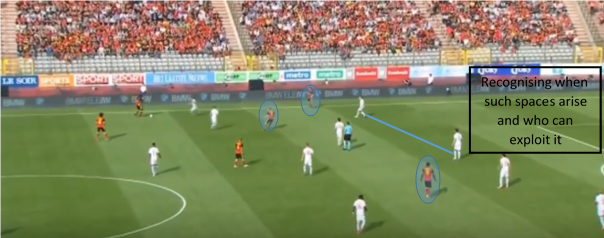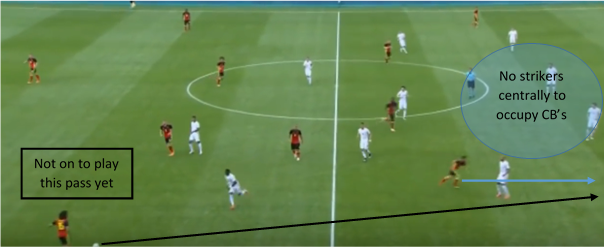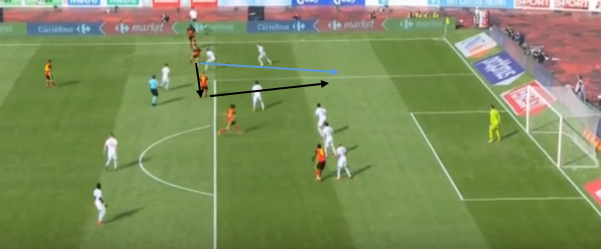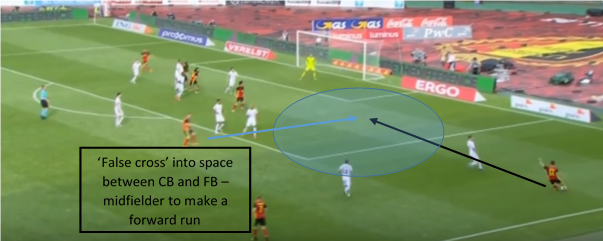Centre backs and full backs have very different responsibilities when out of possession. While centre backs stay in the central zones of the pitch, prioritising to cover the most dangerous areas near the own goal, full backs have the responsibility to pressure opposition wide midfielder, even by the touch line. This will often mean that there will be gaps left between those two players making it a good opportunity for the opposition to exploit them. Arguably the most popular way of exploiting these spaces is a pass to striker, wide or central midfielder making a forward run into ‘channel’. Recent years has seen more a rise of more complex ways to exploit these spaces such as for example ‘false crosses’.
The first stage is to recognise when spaces between full back and centre back arise. Some of the teams play with for example narrow full backs what prevents those spaces to show. The attacking team, however, can encourage and force the opposition to expose more space between their centre back and full back. One of the ways of doing so would be playing with wingers positioned wide, overloading central midfield areas as well as having at least one (ideally two) strikers occupying centre backs.

The most classical way of exploiting spaces between opposition’s CB and FB is a direct pass, usually from the full back into wide midfielder making a forward run off the ball. This kind of movement is triggered by full back being able to play forwards. It is also important to have strikers in central areas to occupy the centre backs.

Another useful attacking strategy might be combination play in wide areas. This might for example include simple one-two between wide midfielder and full back. In this situation it might be useful for wide midfielder to start more centrally to then make a run into wide areas.

Combination play might also include more complex passing options involving central midfielders or strikers. It may also be based around third man run into the spaces between the opposition’s full back and centre back.

Finally, one of the most effective and innovative ways of exploiting these spaces is a ‘false cross’. This is a strategy which aims to isolate opposition’s full back in wide area (pressurising the ball) and create ‘cross likely’ situation to then pass the ball into free space just in behind the full back. Central midfielders have a key role as they are the most likely to make a forward run to receive the pass. Strikers should stay around the goal and try to finalise the action.

Finally, one of the most effective and innovative ways of exploiting these spaces is a ‘false cross’. This is a strategy which aims to isolate opposition’s full back in wide area (pressurising the ball) and create ‘cross likely’ situation to then pass the ball into free space just in behind the full back. Central midfielders have a key role as they are the most likely to make a forward run to receive the pass. Strikers should stay around the goal and try to finalise the action.

Although trying to exploit spaces in between opposition’s centre back and full back can be very advantageous, it should not be the only attacking focus of the team. The attacking strategy should cover other options and possibilities to break through defence as sometimes spaces between FB and CB are not available. Also a number of teams defend in a 3-5-2 or 3-4-3 formations which are not as much exposed to this type of attacking strategy due to ‘half space’ central defenders.
By Alex Trukan, Development Coach, Nottingham Forest
@AlexTrukan

